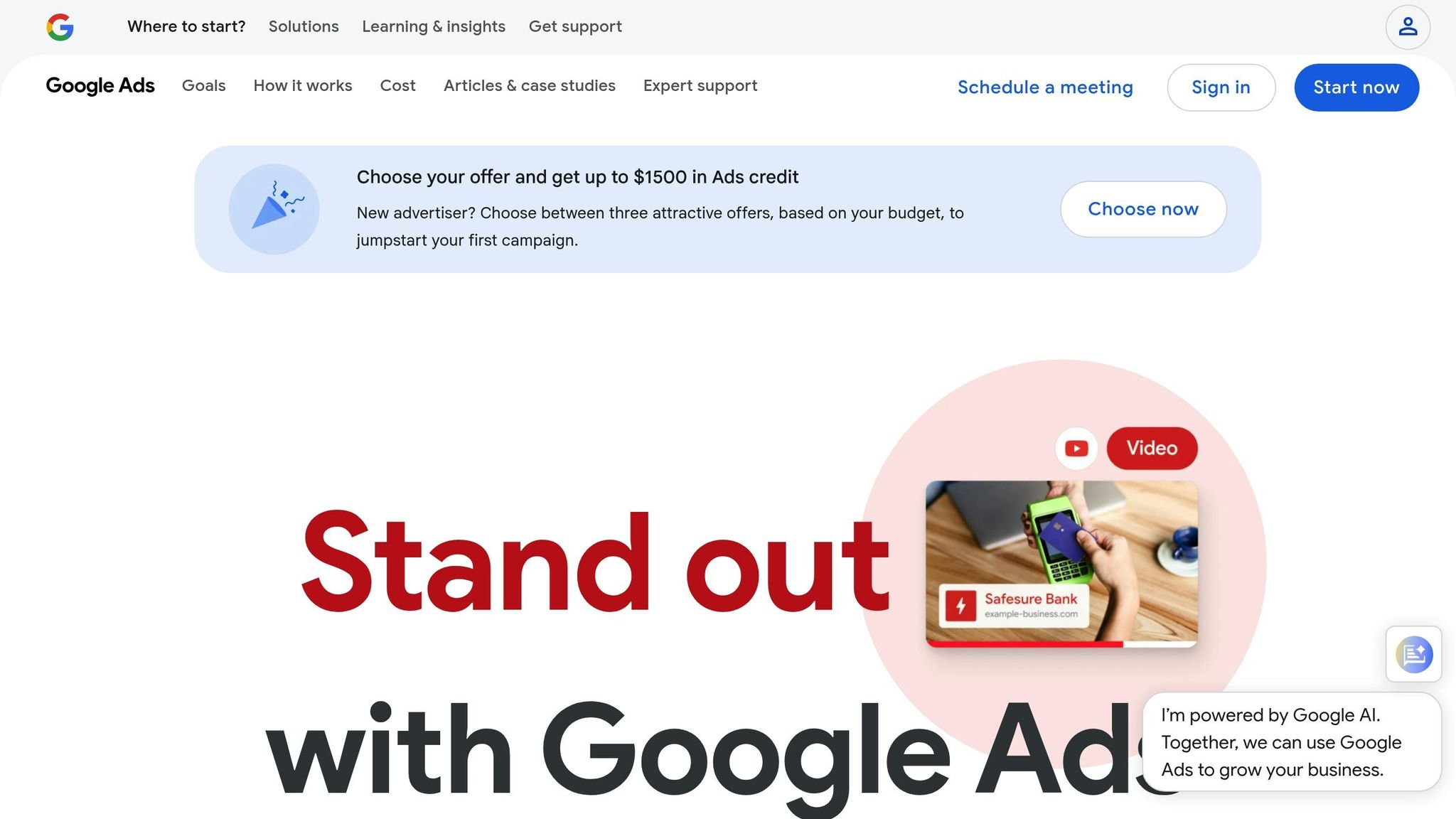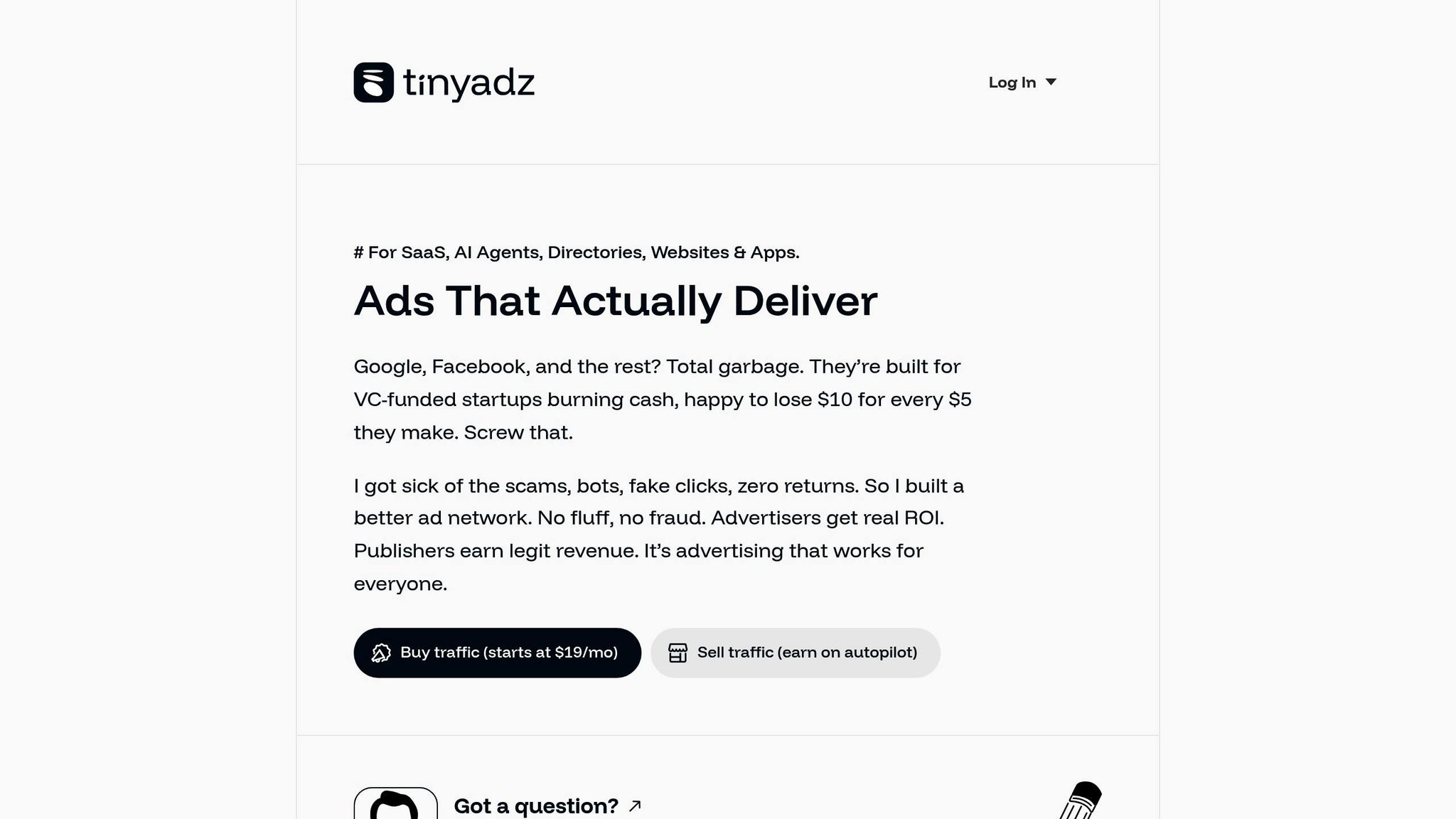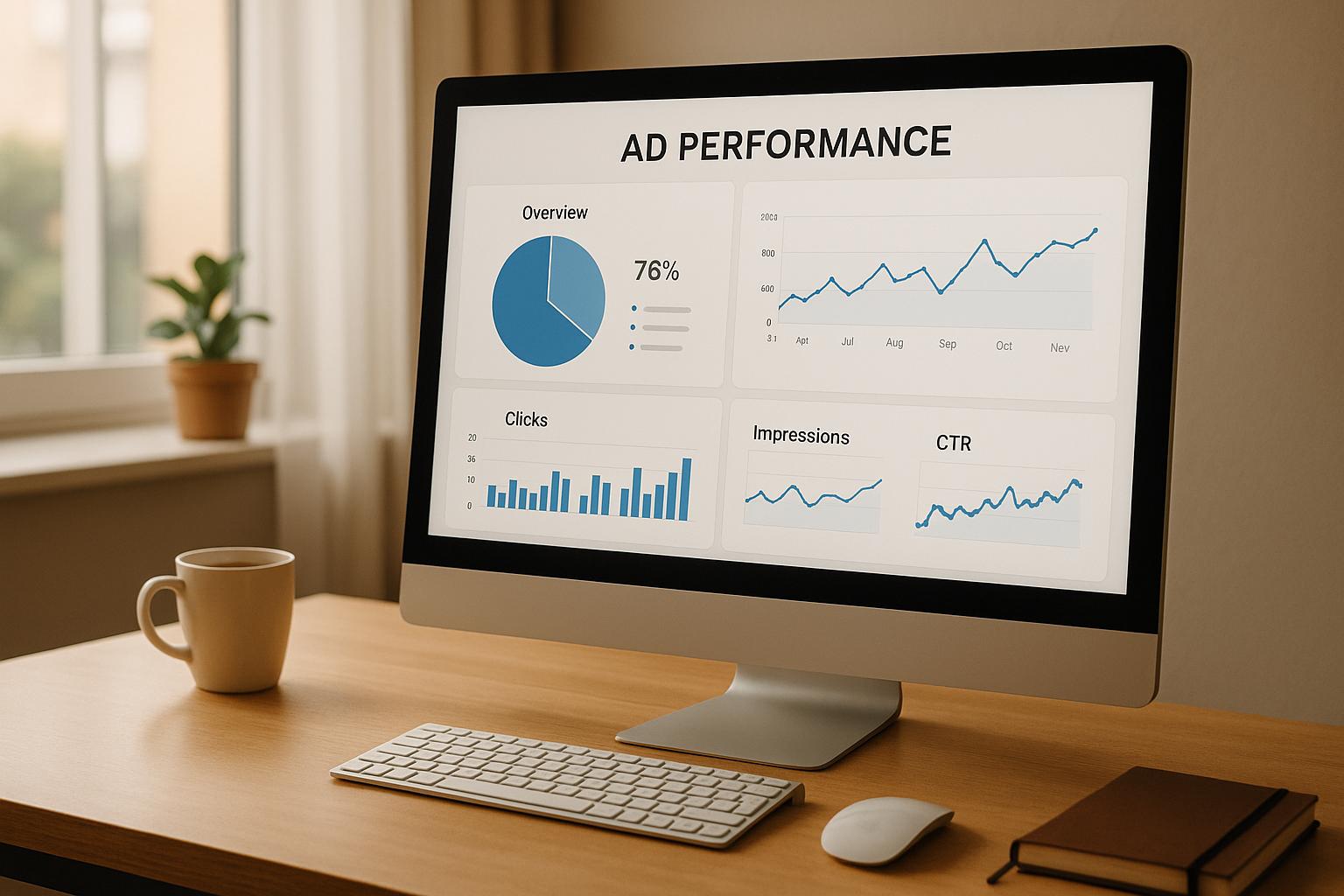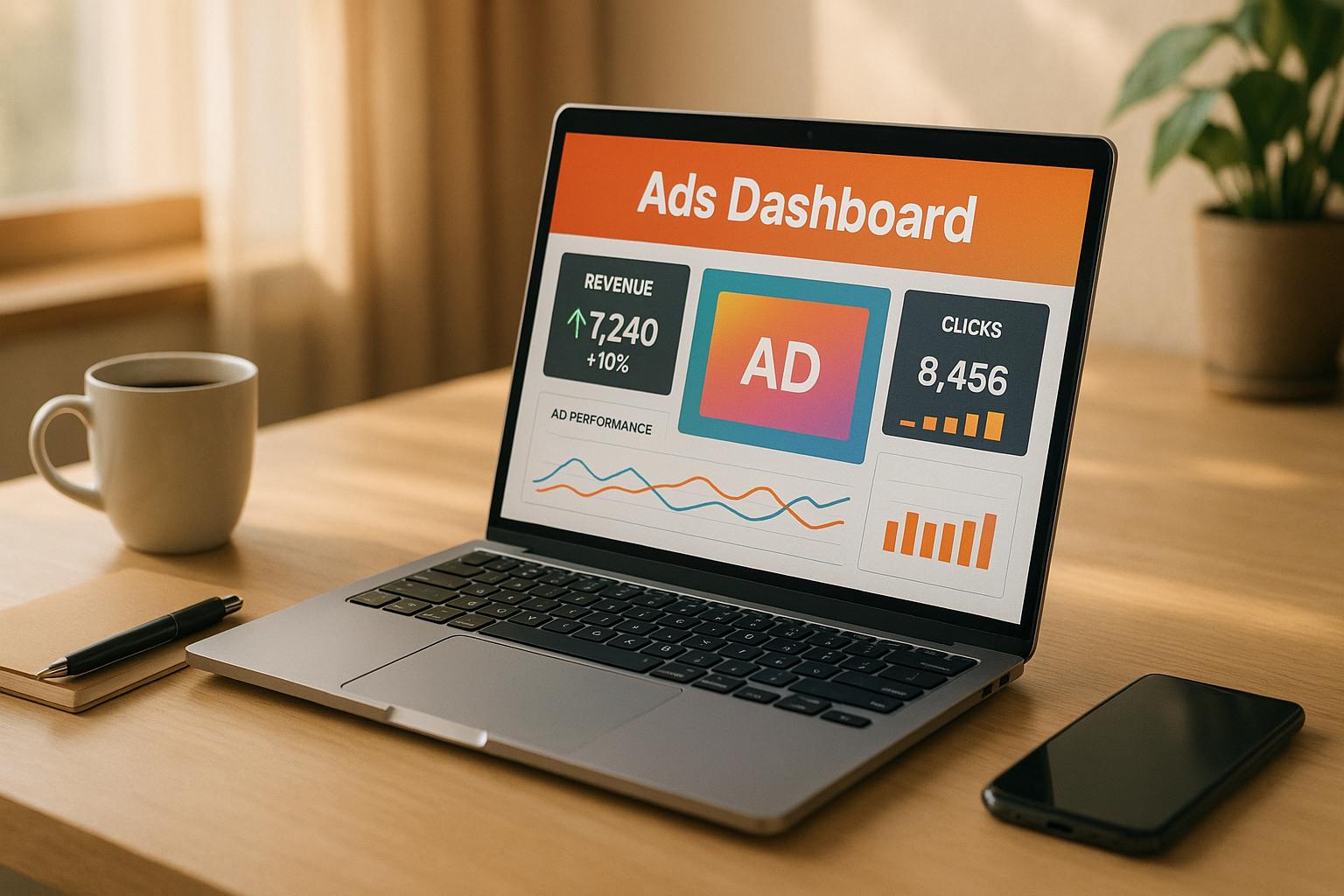Yes, earning money by clicking ads can be legitimate, but it’s not without risks. Here's the quick breakdown:
- How It Works: Click-based revenue models like Pay-Per-Click (PPC) let publishers earn money when users click on ads. Advertisers pay based on metrics like Cost-Per-Click (CPC).
- Benefits: Easy to set up, scalable, and generates passive income as traffic grows.
- Risks: Click fraud, fake traffic, and policy violations can lead to wasted resources and account bans.
- Key Tips: Use platforms with transparent terms, verified traffic, and real-time fraud detection tools.
Quick Comparison
| Feature | Legitimate Platforms | Fraudulent Schemes |
|---|---|---|
| Traffic Quality | Real users | Bots or click farms |
| Payment Reliability | Clear, timely payments | Delayed or missing payments |
| Transparency | Detailed analytics provided | Vague or missing details |
| Compliance | Follows policies | Ignores rules |
To succeed, focus on building genuine traffic, monitor ad performance, and choose trusted platforms like TinyAdz that prioritize quality and transparency.
How to Stop Fake Clicks in Google Ads

How Click-Based Revenue Models Work
Click-based revenue models operate by splitting the revenue generated from ad clicks between advertisers and publishers.
PPC and CPC in Ad Monetization
Pay-per-click (PPC) advertising is a model where advertisers pay a fee for every click their ad receives. This fee is determined by the cost-per-click (CPC), a key metric that helps measure the effectiveness of ad campaigns. For publishers, understanding these metrics is crucial to optimizing ad placement and increasing earnings.
The system relies on a bidding process. Advertisers compete for ad placements by bidding on keywords relevant to their target audience. Higher bids typically secure better ad positions. Publishers, in turn, earn revenue when users click on these ads, with the amount determined by the advertiser's CPC rate. A prime example of this is Google Ads, one of the most prominent PPC platforms, which plays a significant role in driving digital ad revenue.
This bidding and payment framework forms the backbone of how publishers and advertisers collaborate in the digital advertising ecosystem.
How Publishers and Advertisers Work Together
The partnership between publishers and advertisers creates a win-win situation. Publishers provide platforms - such as websites or apps - where ads can be displayed, generating traffic for advertisers. By serving targeted ads to their audience, publishers can generate revenue from engaged and high-quality traffic.
On the other hand, advertisers aim to promote their products or services and convert clicks into actions like purchases or subscriptions. They rely on publishers to deliver traffic through ad networks. When publishers attract quality traffic and advertisers present relevant offers, click-through rates improve, benefiting both sides.
| Category | Advertiser | Publisher |
|---|---|---|
| Primary Goal | Promote products/services and drive conversions | Monetize content or platform by displaying ads |
| Performance Metrics | Click-through rate (CTR), conversion rate, ROI, cost-per-acquisition (CPA) | Page views, bounce rate, fill rate, revenue per thousand impressions (RPM) |
| Key Challenge | Rising ad costs, audience targeting, ad fatigue | Balancing monetization with user experience |
Ad Networks Connect Publishers and Advertisers
Ad networks act as the middlemen, streamlining the connection between advertisers and publishers. They manage ad delivery, audience targeting, and payment processes. By aggregating ad inventory from many publishers, ad networks match it to advertiser demand, automating the buying and selling of ads across websites and apps. This eliminates the need for direct negotiations, making the process smoother for both parties.
For publishers, ad networks provide access to a wide variety of advertisers and ad formats tailored to their audience’s preferences. They also offer analytics and performance tools, enabling publishers to refine their strategies. Advertisers benefit from access to diverse audiences, efficient targeting, and simplified campaign management.
"Ad networks are ecosystems where both roles are equal and valuable. To keep the vital balance of profitability, they help advertisers set the best bids to attract as much high-quality traffic to their offers as possible."
- Adsterra Team
Advanced algorithms in ad networks monitor bids and adjust CPM rates dynamically based on regional or publisher demand. This ensures publishers can maximize their earnings while advertisers get high-quality traffic that justifies their spending. Additionally, ad networks offer flexible pricing models, including CPC (cost-per-click), CPM (cost per mille), and CPA (cost per action), allowing both advertisers and publishers to select strategies that align with their goals and audience.
Understanding these processes is crucial for publishers as they weigh the opportunities and challenges of click-based revenue models.
Is Click-Based Revenue Legitimate? Risks to Consider
Click-based revenue is a legitimate model, but it comes with its share of risks. Fraud and scams in this space are a massive problem, costing businesses billions of dollars. In 2023, global digital ad spending surpassed $600 billion, but fake traffic drained approximately $35.7 billion from advertisers in 2022 alone. To succeed in this space, it's crucial to distinguish between real opportunities and fraudulent schemes.
Fraud remains one of the biggest challenges. Around 90% of PPC campaigns are affected by click fraud, with 10–20% of ad spend wasted on fake traffic. Alarmingly, fraudulent activity grew from 19.3% in 2021 to 28.7% in 2023.
How to Identify Legitimate Platforms
Legitimate platforms make their operations transparent. They provide clear payment terms, use real-time verification tools (often powered by machine learning), and comply with advertising standards. Detailed analytics on traffic and user engagement are also hallmarks of a trustworthy platform. Additionally, platforms with clear terms of service, privacy policies, and accessible customer support are more likely to be reliable.
However, not all platforms are created equal, and certain warning signs can help you spot fraudulent practices.
Common Risks and Red Flags
Several red flags can indicate fraudulent activity in click-based revenue models:
- Unusual Click-Through Rates: If there’s a high number of clicks but no corresponding conversions - like purchases or extended site visits - it might suggest artificial traffic.
- Geographic Inconsistencies: Traffic coming from regions where your business does not operate could signal the use of international click farms or bot networks.
- Short Session Durations: Authentic users typically explore multiple pages or spend time engaging with content. Quick exits or short session lengths may indicate fake traffic.
- Repetitive Traffic Patterns: Regular intervals of clicks or visits often point to automated bots rather than genuine users.
Monica Eaton, CEO of Chargebacks911, highlights the appeal of fraudulent schemes for cybercriminals:
"Cybercriminals love scams that are super-cheap to run, and fraudulent social media ads fit that description perfectly." - Monica Eaton, CEO of Chargebacks911
On top of these, financial scams often promise guaranteed high returns with minimal effort. Genuine click-based revenue models depend on real audiences and valuable content - there are no shortcuts to long-term success.
Legitimate vs. Fraudulent Models Comparison
When comparing legitimate and fraudulent click-based revenue models, the differences are stark:
| Feature | Legitimate Models | Fraudulent Schemes |
|---|---|---|
| Traffic Quality | Real users with genuine interest | Bots, click farms, or incentivized clicks |
| Payment Reliability | Timely payments with clear terms | Delayed, missing payments, or disappearing platforms |
| Transparency | Detailed reporting and clear terms | Vague operations and limited support |
| Compliance | Follows advertising standards and regulations | Ignores ethical and legal requirements |
| Fraud Detection | Active monitoring and prevention | Weak or nonexistent fraud detection |
| User Intent | Reflects authentic engagement | Clicks generated for financial gain without real interest |
| Business Model | Sustainable partnerships with advertisers | Unsustainable schemes reliant on constant recruitment |
The financial risks of choosing unreliable platforms are significant. For instance, JustLaw, an American digital marketing agency, saved over $11,000 in one month by using click fraud detection software to block fake clicks. Their conversion rates improved by 97%, a substantial return given their average cost-per-click was $50.
Neil Andrew, CEO and Founder of Lunio, sheds light on the broader impact of click fraud:
"We know that brands and agencies have a pressure to do more with tighter resources. And click fraud is a huge driver of marketing inefficiency. The lost revenue opportunity for brands as a result of fake traffic polluting their campaigns amounts to billions of dollars per year." - Neil Andrew, CEO and Founder, Lunio
Legitimate platforms focus on connecting advertisers with real audiences, ensuring value for all parties involved. In contrast, fraudulent schemes exploit the system, draining resources and damaging trust in the digital advertising ecosystem.
sbb-itb-957fd63
Long-Term Monetization for Niche Publishers
Sustaining revenue over the long haul requires more than just quick ad clicks - it’s about cultivating an engaged and genuine audience. By focusing on building trust and real connections, publishers can create a steady revenue stream that outlasts fleeting trends.
Why Verified Traffic and Real Audiences Matter
Let’s face it - bots are everywhere. With over 20% of digital ad traffic generated by bots, verified traffic is no longer a luxury; it’s a necessity for publishers looking to secure stable revenue streams. Real audience engagement isn’t just about numbers - it’s about measurable outcomes. Higher viewability translates to better engagement, stronger click-through rates, and improved brand recall. When advertisers see tangible results, they’re more likely to stick around, creating opportunities for premium partnerships and repeat business.
For niche publishers, the value of authentic engagement extends beyond metrics. Loyal readers who regularly interact with content and respond to relevant ads build a foundation for sustainable revenue. Take Assembly Digital, for example. This Canadian media company partnered with GeoEdge to enforce strict ad quality standards. By doing so, they shifted from daily ad monitoring to weekly oversight, all while improving user experience and boosting ad performance.
Direct and organic traffic plays a pivotal role here. It not only drives engagement but also enhances a publisher’s credibility. Reliable traffic fosters loyalty, which in turn attracts advertisers looking for meaningful connections with real audiences. This creates a cycle where quality content brings in genuine readers who engage with ads, ensuring long-term financial stability.
Strong relationships with readers are the cornerstone of a successful publishing strategy. By investing in newsletters, personalized content, and SEO, publishers can establish multiple touchpoints for engagement. This reduces reliance on unpredictable external traffic sources while reinforcing brand authority and trust.
How TinyAdz Supports Publisher Monetization

TinyAdz is a platform that understands the unique needs of niche publishers, offering tools to connect with real audiences and generate sustainable revenue. Advertisers are promised 100% human impressions, ensuring that publishers earn legitimate income.
TinyAdz offers a variety of monetization options tailored to different types of content:
- Banner Ads: These ads are designed to blend seamlessly with your site, providing targeted placements that enhance user experience rather than disrupt it. Unlike traditional networks, TinyAdz ensures ads are relevant to your audience.
- Directory Monetization: If you curate resource lists or vendor directories, TinyAdz can help monetize these assets by incorporating natural, targeted ad placements.
- Social Media: Recognizing that niche publishers often engage audiences across platforms, TinyAdz provides tools to monetize your presence on Twitter, LinkedIn, Facebook, and more - all while maintaining genuine interactions with your followers.
- Newsletters: With personalized matchmaking, TinyAdz connects advertisers with publishers to place ads that align with subscriber interests. This approach turns email lists into a dependable revenue source without compromising trust.
- Event Sponsorships: For publishers hosting webinars, conferences, or virtual meetups, TinyAdz facilitates ad placements and sponsorships that integrate smoothly into events without disrupting the attendee experience.
What sets TinyAdz apart is its transparency. The platform provides clear reporting tools, so publishers can easily track earnings and optimize their strategies over time. Unlike other networks that obscure revenue details, TinyAdz prioritizes straightforward metrics.
"TinyAdz is a better ad network. No fluff, no fraud. Advertisers get real ROI. Publishers earn legit revenue. It's advertising that works for everyone."
Another standout feature? There’s no minimum traffic requirement. This makes TinyAdz accessible to smaller publishers who might not qualify for traditional ad networks, giving them a chance to grow their audience while monetizing their content. By connecting publishers with advertisers that genuinely resonate with their readers, TinyAdz drives engagement and maximizes revenue potential.
Best Practices for Safe Revenue Generation
Generating revenue through click-based advertising requires a thoughtful strategy that balances immediate returns with long-term growth. The key? Building trust with advertisers by focusing on quality traffic and adhering to policies that safeguard your account. Below, we dive into core strategies that not only protect your revenue streams but also ensure sustainable success.
Maintaining Traffic Quality and Policy Compliance
Quality traffic is the backbone of your ad revenue. As a publisher, you're fully accountable for the traffic your ads receive. Google AdSense emphasizes this responsibility:
"AdSense publishers are ultimately responsible for the traffic on their ads. For this reason, it's critical that you monitor your ad traffic to ensure that your account is compliant with our policies and not accruing invalid traffic."
To maintain this standard, work with reputable ad networks and leverage ad verification tools to spot and address bot activity or suspicious traffic patterns. Strengthen your audience targeting by using tools like geotargeting, device filtering, and audience segmentation. This not only improves user engagement but also minimizes exposure to low-quality traffic. Dive into your analytics regularly to identify signs of invalid traffic and focus on metrics that measure genuine engagement, such as sign-ups, purchases, or downloads. To further refine your traffic sources, maintain a whitelist of trusted websites and remove those with consistently poor performance, such as high bounce rates.
This approach can deliver tangible results. For instance, Sensorem, a direct-to-consumer brand, saw a 2x improvement in conversion rates after halting campaigns with low scroll depth and engagement time.
Tracking Performance Metrics
Tracking the right metrics is essential for optimizing revenue. As H.J. Harrington aptly stated:
"If you can't measure something, you can't understand it. If you can't understand it, you can't control it. If you can't control it, you can't improve it."
To fine-tune your strategy, monitor key metrics like click-through rates, conversion rates, and Core Web Vitals. These indicators provide actionable insights into your ad performance. For example, understanding industry benchmarks, such as the 71.5% global viewability rate for desktop display ads in the first half of 2022, can help you assess where you stand and identify areas for improvement.
Using Clear Reporting Tools
Accurate tracking naturally leads to better reporting, which is a cornerstone of building trust with advertisers. Transparent reporting not only strengthens partnerships but also ensures you can quickly address payment or performance discrepancies. Tools that prioritize clear, straightforward reporting - like TinyAdz - allow publishers to track earnings effectively and refine their strategies over time. Regular reviews of these reports help identify trends and make data-driven adjustments that enhance your overall approach.
By sharing detailed performance insights with advertisers, you demonstrate accountability and build stronger relationships. These efforts ensure your monetization strategy remains both effective and trustworthy.
Approaching ad monetization as a long-term business strategy - focusing on quality traffic, robust performance tracking, and transparent reporting - sets the stage for sustained success in the competitive world of digital advertising.
Conclusion: Making Smart Decisions About Click-Based Revenue
Click-based revenue can be a reliable income source when managed with care. But it’s not without its challenges. For instance, click fraud resulted in losses exceeding $35 billion for advertisers in 2020, and bots accounted for over 20% of traffic. These risks highlight the importance of choosing platforms that prioritize quality and transparency.
To navigate these challenges, thorough evaluation is crucial. Look for platforms that offer clear reporting, enforce strict traffic-quality standards, and uphold strong brand safety measures. As the IAS Team puts it:
"Ad verification is the process of ensuring that ads are delivered as intended. This involves confirming that ads appear in front of human eyes (viewability), are protected against fraudulent activities (ad fraud), and are placed in environments that align with the brand's safety guidelines (brand safety)."
When traffic is verified, publishers benefit from genuine engagement, higher click-through rates, and long-term revenue stability. This creates a fair ecosystem where advertisers achieve real results, and publishers earn income they can trust.
TinyAdz exemplifies this approach by connecting niche publishers with advertisers through verified traffic and transparent reporting. By focusing on quality over short-term gains, they help foster sustainable growth.
To maintain a balanced and ethical revenue model, monitor ad performance regularly and scrutinize traffic for irregularities . These steps are key to ensuring compliance and maintaining high traffic quality.
With global ad fraud losses projected to hit $88 billion, picking platforms that verify traffic and provide transparent reporting isn’t just smart - it’s essential for protecting your reputation and revenue. Smart decisions today pave the way for sustained success tomorrow.
FAQs
How can I tell if a click-based revenue platform is legitimate or a scam?
To spot genuine click-based revenue platforms, focus on transparency and robust reporting tools. Trustworthy platforms offer detailed analytics, including real-time data on clicks and conversion rates, so you can monitor authentic user engagement. Be wary of suspicious patterns, like sudden surges in clicks from unusual locations or odd hours, as these could signal fraudulent activity, such as bots or click farms.
Legitimate platforms also stand out with clear terms of service, straightforward payment policies, and a track record of positive user feedback. Avoid platforms that make exaggerated income promises or demand upfront fees. By staying vigilant and prioritizing these factors, you can safeguard your revenue and steer clear of scams.
How can I ensure high-quality ad traffic and protect against click fraud?
To ensure your ad traffic remains legitimate and to guard against click fraud, start by integrating real-time monitoring tools into your campaigns. These tools are designed to catch and block suspicious activities, such as invalid clicks or bot-generated traffic. They can spot unusual patterns, like repeated clicks from a single IP address or erratic user behavior, helping you address issues before they escalate.
In addition, conducting regular audits of your ad campaigns is a must. Take time to review your traffic sources, implement geo-targeting to focus on specific areas, and use IP exclusion to block sources known for fraudulent activity. By staying vigilant and keeping a close eye on performance metrics, you can maximize your ad budget's impact and ensure it reaches real users who are likely to engage with your content.
Why is building genuine audience engagement essential for stable, long-term revenue?
Building real connections with your audience is crucial for steady, long-term revenue. Why? Engaged customers tend to stick around, spend more regularly, and even promote your brand to others. Research highlights that engaged customers often contribute far more to a company’s revenue than those who are less involved.
On top of that, keeping your audience engaged can help cut marketing costs. Loyal customers are less likely to leave, which means lower churn rates and more repeat business. By creating meaningful relationships with your audience, you’re not just boosting revenue - you’re laying the groundwork for consistent growth while steering clear of the pitfalls tied to quick, short-term revenue grabs.


